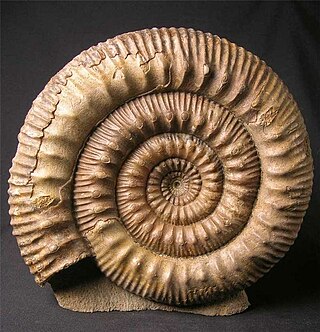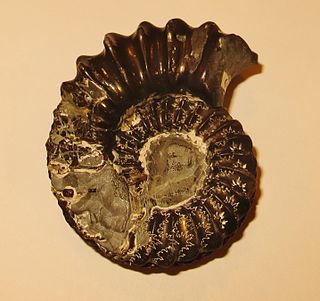Related Research Articles

Stephanoceras is an extinct genus of Stephanoceratoid ammonite which lived during the Bajocian. It is the type genus of the family Stephanoceratidae.

Xipheroceras is a Lower Jurassic ammonite belonging to the Eoderoceratidae, and sometimes placed in the subfamily Xipheroceratinae for which it is the namesake. It has been found in the upper Sinemurian of Europe and possibly Borneo.
Aulacosphinctoides is an extinct ammonoid cephalopod that lived during the Late Jurassic, included in the ammonitid family Perisphinctidae.

Audaxlytoceras is an extinct genus of lytoceratid ammonites.

Arcticoceras is an extinct ammonoid cephalopod genus from the late Middle Jurassic belonging to the ammonite family Cardioceratidae, more commonly found to high northern latitudes.
Aegoceras (Beaniceras) is small, coarsely ribbed subgenus ammonite from the Lower Jurassic with coarsely ribbed rounded whorls. The shell is evolute, early whorls a barrel-shaped cadicone, later become serpenticonic.
Euaptetoceras is an evolute hildoceratoid ammonite from the lower Middle Jurassic, included in the family Hammatoceratidae and the subfamility Hammatoceratinae. The genus may be a junior synonym for Eudmetoceras of Buckman, 1920.
Parastrenoceras is an extinct genus from the ammonoid cephalopod order Ammonitida, included in the family Spiroceratidae that lived during the Bajocian stage of the Middle Jurassic.
Oecotraustes is an extinct cephalopod genus included in the ammonid family Oppeliidae and named by Wilhelm Waagen in 1869. Species in the genus lived during the Middle Jurassic.
Oecoptychius is an extinct genus of fossil ammonite cephalopods. The species lived during the Middle Jurassic.

Normannites is a strongly ribbed evolute Middle Jurassic genus of ammonite included in the stephanoceratoid family Stephanoceratidae.

Peltoceras is an extinct ammonite genus from the aspidoceratid subfamily Peltoceratinae that lived during the later part of the Middle Jurassic.

Hecticoceras is an ammonite genus belonging to the haploceratoid family Oppeliidae, that lived during the Middle and Late Jurassic, from the Callovian. Hecticoceras may be seen as a series of some nine subgenera, beginning with the lower Callovian H. (Hecticoceras) and H. (Hecticoceratoides) and ending with the lower Oxfordian H. (Pseudobrightia) and H. (Eochetoceras). Hecticocerassensu lato and Prohecticoceras from the underlying Bathonian form the oppeliid subfamily, Hecticoceratinae.

Craspedites is an ammonoid cephalopod included in the Perisphinctoidea that lived during the Late Jurassic and Early Cretaceous, found in Canada, Greenland, Poland, and the Russian Federation.

Cymatoceras is a wide-ranging extinct genus from the nautilitacean cephalopod family, Cymatoceratidae. They lived from the Late Jurassic to Late Oligocene, roughly from 155 to 23 Ma.

Lytoceratinae is a subfamily of ammonoid cephalopods that make up part of the family Lytoceratidae.

Schlotheimia is a genus of extinct cephalopods belonging to the subclass Ammonoidea that lived during the Hettangian stage at the beginning of the Early Jurassic.
Dasyceras is an early phylloceratid from the Sinemurian stage of the lower Jurassic, found in Europe.

Harpoceras is an extinct genus of ammonite belonging to the family Hildoceratidae. These cephalopods existed in the Jurassic period, during the Toarcian age from the Falciferum zone to the Commune subzone of the Bifrons zone. They were fast-moving nektonic carnivores.
Reynesocoeloceras is genus of ammonite that lived during the lower Pliensbachian stage of early Jurassic, ammonite zones Ibex—Davoei.
References
- ↑ Sepkoski, Jack (2002). "Sepkoski's Online Genus Database" . Retrieved 2014-05-28.
- 1 2 Paleobiology Database - Pleuroacanthites. 2017-10-18.
- W.J Arkell et al., Systematic Descriptions, Mesozoic Ammonoidea, Treatise on Invertebrate Paleontology, Part L (1957) p. L193